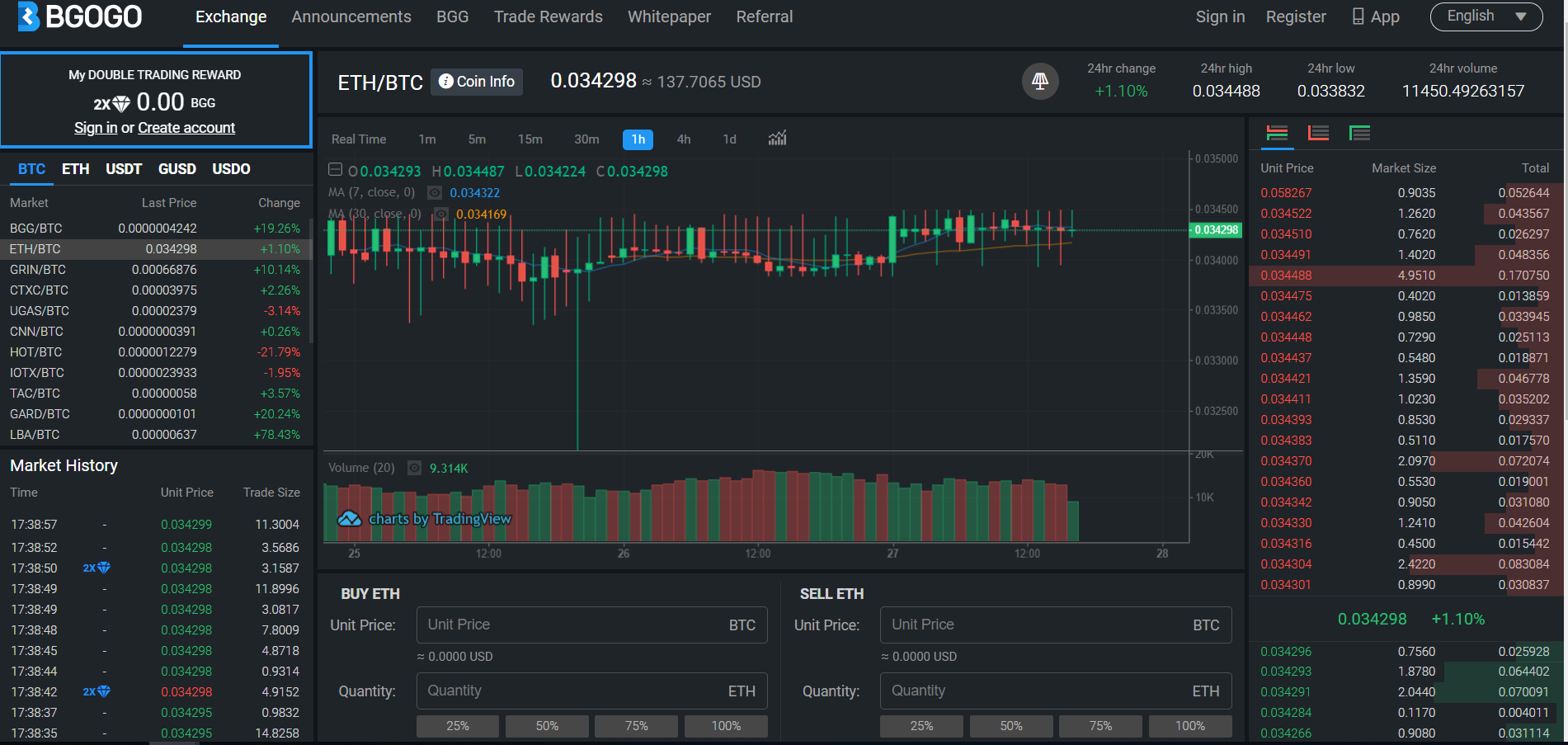
Bgogo

Exchange Fees
Deposit Methods
Cryptos (22)
UPDATE 31 August 2021: Bgogo has decided to close down the centralized part of their exchange platform, and rebranded the decentralized part of its platform into Gogoswap. They announced this through the following message on their website:
1. We are glad to announce that the decentralized exchange (DEX) version of Bgogo is online now. The new decentralized exchange website is https://gogoswap.finance. Gogoswap will have the same trading functionality but much better user experience. Gogoswap is safer, faster and easier to use.
2. We will have a three-month transition period, and Bgogo will completely evolve from a centralized exchange to a decentralized exchange to capture the trend of decentralization in this industry. Bgogo will co-exist with Gogoswap for next three months to complete the transition period.
3. All users can become familiar with the trading operations of the decentralized exchange Gogoswap as soon as possible during the transition period. (Please refer to link for specific operation guide)
4. The old centralized exchange Bgogo.com will stop trading before August 31, 2021. All users shall withdraw their assets from centralized exchange to their only wallets, and connect to Gogoswap to use and feel the revolutionary changes brought by the decentralized exchange.
5. In addition to being allocated to liquidity providers, transaction fees of Gogoswap will be used to repurchase BGG as before.
Accordingly, we have marked the platform as "dead" in our Exchange Graveyard.
Bgogo Review
What is Bgogo?
Bgogo is an exchange registered in the Cayman Islands. It has been active since 2018. The founders of the exchange apparently include members from well-known companies such as Facebook, Twitter and IBM. Also, the exchange states on its website that the core engineering team “consists of several world champions of the ACM International Collegiate Programming Contest.”
Another interesting feature is that Bgogo has a “VIP service ecosystem”. To qualify as a VIP you need to hold at least 3 million BGG-tokens (the exchange’s own tokens). Apparently, when you are a VIP you receive special benefits, such as gifts and enhanced customer support.
US-investors
As many other exchanges, Bgogo does not accept US-investors on its platform. If you’re from the US and you’re looking for the trading platform that is just right for you, don’t worry. Use our Exchange Finder to find an appropriate exchange accepting US-investors.
Trading Volume
On the date of last updating this review (2 December 2021) the 24-hour trading volume was USD 6.9 million compared to USD 4.5 million on 10 September 2021, according to Coinmarketcap.com.
Trading Rewards
Bgogo also has a certain system in place that they call “Trading Rewards”. Essentially, the system rewards users with 200% of their trading fees in Bgogo-tokens. If you’re lucky, you might even receive 2x that. Whether or not you receive the double multiplier depends on how many “BGG HODL Points” you have accumulated. More detailed can be found at the Bgogo-website, but this picture is the exchange’s main illustration of it:

Supernodes
Different from most other cryptocurrency exchanges, Bgogo’s claim to fame is that they have “supernode listing authority”. These are the top 19 supernodes at Bgogo on the date of writing this review:

If you run a supernode, you can enjoy certain benefits. For instance, each supernode gets a “one vote, one listing”, meaning influence over which other cryptocurrencies that are listed on the Bgogo platform. Each supernode also receives a 20% share of the trading fees generated, for life.
Bgogo Savings
On 19 September 2019, this exchange launched something called Bgogo Savings. This is a high-yield, low-risk wealth management product that has apparently become quite popular among investors. The first Bgogo savings product was a 14-day period USDT-based wealth management product and it was bought out in less than 24 hours according to information on this exchange’s website. We will monitor these products more closely and provide a more helpful summary of them here shortly.
Bgogo Trading View
Different exchanges have different trading views. And there is no “this overview is the best”-view. You should yourself determine which trading view that suits you the best. What the views normally have in common is that they all show the order book or at least part of the order book, a price chart of the chosen cryptocurrency and order history. They normally also have buy and sell-boxes. Before you choose an exchange, try to have a look at the trading view so that you can ascertain that it feels right to you. This is the trading view at Bgogo:

Bgogo Fees
Bgogo Trading fees
Trading fees are naturally very important. Every time you place an order, the exchange charges you a trading fee. The trading fee is normally a percentage of the value of the trade order. At this exchange, they don’t divide between takers and makers. Each party to a transaction pay the same fee: 0.10% of the order value. 0.10% is below the industry average. Industry average has for a long time been 0.25%, but we are currently seeing a shift towards lower fees. Many exchanges now charge e.g. 0.10% or 0.15% instead.
Bgogo Withdrawal fees
Bgogo charges a withdrawal fee amounting to 0.0005 BTC when you withdraw BTC. This is substantially below the industry average, as the industry average is 0.000812 BTC per BTC-withdrawal. Bgogo’s withdrawal fees are thus roughly 40% lower than industry average.
All in all, the fees at Bgogo are very competitive.
Deposit Methods
This exchange does not accept any other deposit method than cryptocurrencies, so new crypto investors are restricted from trading here. If you are a new crypto investor and you wish to start trading at this exchange, you will have to purchase cryptos from another exchange first and then – as a second step – deposit them here. Don’t worry though, you can find a so called “entry-level exchange” simply by using our Exchange Finder tool.